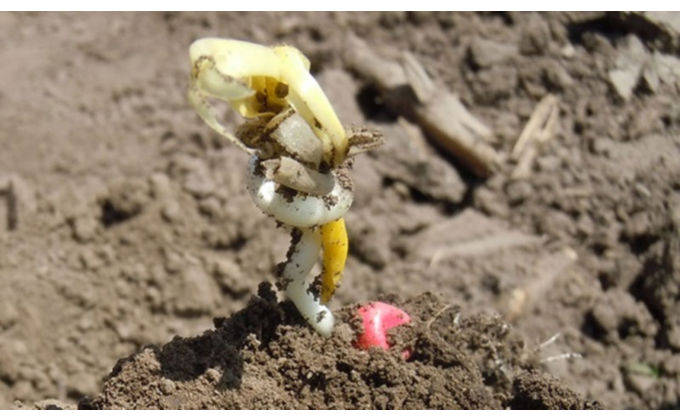Ontario Field Crop Report, April 29, 2021
Winter wheat Winter wheat acreage is up by 8% compared to the 2020 growing season (Statistics Canada). In general, the winter wheat crop looks very good throughout the province. Cold weather caused some temporary leaf necrosis (leaf tip burn) in a few fields. This leaf burn is sometimes made worse when a herbicide is applied […]
Exeter + Mt Forest Ag Breakfast Meeting Minutes – April 27, 2021

Winter Wheat Depending on the region, about 75 growing degree days (GDD) have accumulated since the last meeting.. It takes about 100 GDD for wheat to advance through each growth stage, so wheat has not been growing quickly during the cool weather the past two weeks. In many areas it is still at growth stage […]
2020 Canola Seasonal Summary

Canola acreage in Ontario was similar to last year, with 29,019 acres insured in 2020. Spring canola acres have declined in most regions, including a drop in Temiskaming District from about 11,300 acres in 2019 to about 9,300 acres in 2020. Nipissing added 700 acres compared to last year, for a total of nearly 2000 […]
OMAFRA Field Crop Report – June 25, 2020

Wheat Pests are Still a Concern True armyworm (TAW) larvae are in many winter wheat and spring cereal fields across southern Ontario, thankfully not always at threshold. Some fields have populations at threshold (4-5 unparasitized larvae smaller than 2.5 cm per square foot) or above and with minimal feeding damage. Larvae sometimes choose not to […]
Impacts of Climate Change on Current and Future Crop Pests in Ontario

Tracey Baute, Field Crop Entomologist, OMAFRA Climate change will have a direct impact on insect pests. Since insects are cold blooded, they are directly influenced by temperature. Those that feed on plants also rely on the availability of their host crops to survive. Though we have an idea of some of the impacts climate change […]
OMAFRA Field Crop Report – April 30, 2020

Corn: Planting began at the tail end of the week of April 20 and continued at a good pace until the widespread rain event on Wednesday/Thursday during the week of April 27th. Many agronomists have commented that soil conditions have been exceptional given the calendar date and what recent spring conditions have been like. As […]
Exeter + Mt. Forest AgriBusiness Breakfast Meeting Minutes – April 28, 2020

As a reminder, participants can join breakfast meetings by phone without using the Zoom app or logging onto the Zoom website by using the number provided in the breakfast meeting listserv. Corn planting began in earnest on Thursday and continued through Monday. Some producers are nearly done their corn acres, particularly on light ground in […]
Canola Seasonal Summary 2019
Spring Canola Planting and Development Spring canola acreage in Ontario declined 25 per cent in 2019 compared to the previous year. Insured acres totaled just over 30,000 compared to approximately 40,000 in 2018. Five counties that grew canola in 2018 did not appear in the insured acreage statistics this year. Some producers were unable to […]
Ontario Field Crop Report – Week of May 27th, 2019
Planting progress remains slow for all crops, and spray applications have also been significantly delayed by poor weather. Temperatures forecasted for early June are relatively cool, remaining around or below the 20°C mark in many regions. Corn Corn planting progress at the end of May was estimated to be less than 50% complete. In some […]
Can double cropping winter canola and soybean kill two birds with one stone?

This article was written by Dr. Eric Page, Research Scientist in Weed Ecology, and Sydney Meloche, Weed Science Technician, AAFC Harrow Research and Development Center Soybean production in southwestern Ontario is increasingly challenging because of the presence of multiple glyphosate resistant weed species. Essex, Kent and Lambton counties have the unfortunate distinction of being home […]
2016 Canola Seasonal Summary

Planting and Development Canola acres in Ontario were higher in 2016 than they were in 2015. The total number of insured canola acres in 2016 was just shy of 30,000 acres, compared to 25,000 acres in 2015. With a drier than normal spring throughout much of the province, canola growers were able to plant early. […]
Mt Forest Ag Breakfast Meeting Minutes – June 14, 2016

There is still a lot of field activity happening, but the real busy rush is starting to slow down. Accumulated heat units are shown in the table below. Thanks Bill Brown and FS Partners for sponsoring breakfast. The June 14 meeting was the last of the year at Mt Forest, and we thank everyone for participating. […]
Canola Swede Midge Update: Populations Peak with Hot Weather
Our trap counts of adult swede midge this week have spiked to high levels in some areas. To view a map indicating swede midge trap catches go to Ontario Canola Grower’s website at www.ontariocanolagrowers.ca. Regularly check this website for updates on the level of swede midge in your growing area until your canola is beyond the […]
Look out for these Insects and Diseases
Synopsis Canola is advancing rapidly with April planted canola now bolting to 70% flower stage. Some canola stands are thin and uneven in growth which has growers questioning need or timing for fungicide. The biggest risk factors for sclerotinia are adequate soil moisture, rainfall during flowering, 48-72 hours of wetness in canopy for infection to […]
Palmerston Crop Consultants June 5, 2012 Meeting
Synopsis: Most areas received between 1-2″ of rain, although few areas (Goderich) only received 1/2 this amount.. Fungicide application to wheat is ongoing with most fields sprayed. Corn advanced for leaf stage. Populations of corn and soys generally excellent although those planted last 10 days variable. Watch for armyworm, alfalfa weevil, cabbage seedpod weevil(canola). Wheat: […]